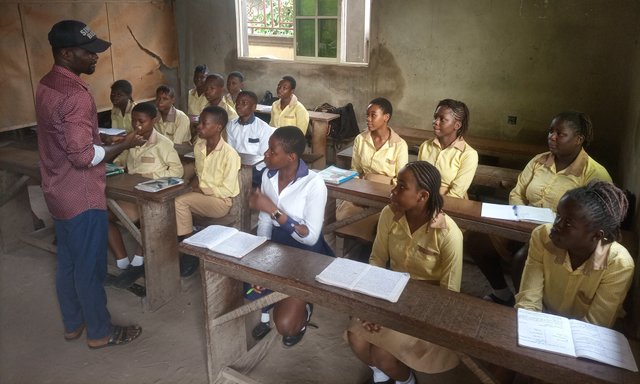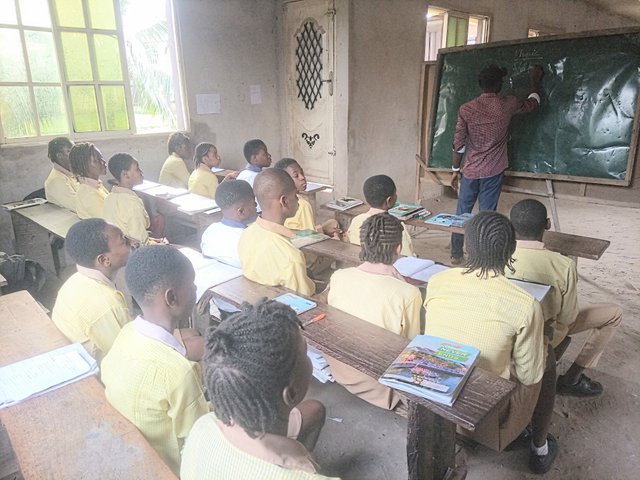SLC | S21W3 : Teaching Practice
Tell us what your specialty is and what you would like to teach your students in the next hour-long meeting? |
|---|
I am a Civil Engineering graduate and specialized in Structural Engineering. As a structural engineer, I design and execute structures ensuring that they remain functional regardless of high winds and most natural disasters. Gravitational properties are studied to ascertain the mass they can handle.
Nevertheless, in my little teaching profession I teach Physics which is core to my profession and today in the class I will be delivering a lecture on "Vectors."
 Lecturing On Vectors Lecturing On Vectors |
|---|
Tell us about how the learning takes place from the beginning to the end (input-process-output)? |
|---|
Learning is actually a complex and multi-faceted process that involves different phases, mechanisms, as well as factors. Here is my exhaustive overview of how learning takes place from the start to the finish:
Phase 1: Motivation and Readiness
The learning process commences with motivation and readiness. Students or learners must be aroused to learn and have an appetition to gain new knowledge or skills.
In the lesson plan, this is referred to as " set induction"; a process in which the teacher deploys a method or approach to incite the students or learners for the class.
Phase 2: Perception and Attention
As soon as the students or learners are incited, aroused, motivated, and ready, they start to perceive and attend to the instructional or learning materials. This involves choosing directly related or applicable information, selectively removing distractions, and concentrating on the learning task.
This is referred to as "entry behavior" in the lesson, a strategy used by the tutor or teacher to capture and retain the attention of the students or learners.
Phase 3: Encoding and Processing
As students attend to the instructional materials, encoding, and processing of the information begins to take place. This involves converting the information into a meaningful and rememberable form, employing cognitive processes like attention, perception, and memory.
For this reason, the teacher tries to make the lesson very explicit, using any workable techniques such as class discussion, explanation method, question and answer method, or incorporating all in the learning process. This process or phase has to do with "instructional techniques".
Phase 4: Storage and Consolidation
The lesson is stored in a long-term memory as soon as it is encoded and processed. This process or phase involves making the lesson more stronger or solid through repetition, practice, as well as review.
The teacher, at this point, engages the students or learners in the lesson, giving them a chance to contribute their ideas or knowledge of the context, asking them questions, and allowing them to answer and make corrections where necessary. This is known as "students/teachers performance activities".
Stage 5: Retrieval and Application
As soon as students are required to recall the learned information, they recall it from long-term memory. This involves having access to the stored lesson and applying it as required.
This phase is called "evaluation stage". It is a stage where the teacher, at the end of the lesson, evaluates the students to ascertain how well the lesson has been assimilated as well as if the outlined objectives in the lesson plan have been achieved.
Phase 6: Feedback and Reflection
This is the last phase of the learning process that involves taking feedback as well as introspecting the learning experience. This is essential for progress evaluation, identifying areas requiring improvement, and adjusting teaching/learning strategies.
This phase has to do with "appraisal and criticism". At this stage, the teacher allows the students the privilege of self-expression to either appraise or criticize the learning process. This provides room for adjustments for both parties making it a win-win situation.
Factors Influencing Learning
There are several factors that influence these learning processes and they include:
- Motivation
- Emotions
- Prior knowledge
- Learning environment and
- Instructional design
The knowledge and understanding of these stages and factors involved in the process of learning helps in optimizing the approach to learning and enhances overall outcomes.
How do you ensure that after the learning activity there are changes in the cognitive, affective and psychomotor aspects of students? |
|---|
To ensure that after the learning activity, there are changes in the cognitive, affective, and psychomotor aspects of students, the following strategies should be considered:
Cognitive Aspect
- Clear Learning Objectives: For each learning activity, establish MARTS objectives. MARTS stands for: Measurable, Achievable, Relevant, Time-bound.
- Relevant and Engaging Content: Employ relevant, recent, and engaging content that provides for various learning styles.
- Active Learning Techniques: Include active learning methods like class problem-solving, discussions, case studies, and debates to promote meticulous thinking and analysis.
- Formative Assessments: Conducting frequent formative evaluations to track students' progress, spotting areas of improvement, and adjusting instruction accordingly.
- Feedback and Reflection: Make constructive feedback attainable and encourage students to ponder on their learning, set objectives, and cultivate a growth mindset.
Affective Aspect
- Emotional Connection: Emotional connection with the learning materials should be created by employing real-life instances, stories, or scenarios that influence students' interests and experiences.
- Positive Learning Environment: Nursing a positive learning environment that encourages social conversation, collaboration, and reciprocal respect among students and teachers.
- Empathy and Understanding: Promote empathy and comprehension by including varied perspectives, encouraging cultural awareness, as well as addressing social and emotional problems.
- Self-Awareness and Self-Reflection: Assist students in developing self-awareness and self-reflection skills to cognize and bewield their emotions, values, as well as attitudes.
- Intrinsic Motivation: Nursing immanent motivation by the provision of options, autonomy, as well as chances for students to assume proprietorship of their learning.
Psychomotor Aspect
- Hands-On Activities: Including hands-on activities, simulations, and experiments that permit students to exercise and put to use new skills and knowledge.
- Skill-Building Exercises: Providing skill-building exercises like role-plays, symposiums, group work, as well as presentations to advance or promote the growth of students' coordination, motor skills, and dexterity.
- Real-World Applications: Linking learning to verifiable or real-world applications and scenarios, enabling students to perceive the practical pertinence and utility of the skills and knowledge.
- Feedback and Correction: Provision of productive feedback and correction for assisting the students in refining their skills and improving their performance.
- Practice and Reinforcement: Offering chances for practices and reinforcements to assist students strengthen new skills and knowledge.
Assessment and Evaluation
- Comprehensive Assessment: Employing a comprehensive evaluation approach that assesses students' affective, cognitive, and psychomotor skills.
- Rubrics and Criteria: Create explicit rubrics and criteria for assessing the performance of students and providing constructive feedback.
- Self-Assessment and Peer-Assessment: Promoting self-assessment and peer assessment for the encouragement of reflection, meticulous thinking, and collaborativeness.
- Formative and Summative Evaluation: Using both formative and summative assessments to track students' progress, spotting areas requiring improvement, and evaluate the efficiency of instruction.
Incorporating these strategies can guarantee that learning activities will result in changes in the affective, cognitive, and psychomotor aspects of students.
 |
|---|
Whether the methods and strategies you use are appropriate, how do you develop methods and strategies in future learning meetings? |
|---|
A reflective and intentional approach is involved in developing methods and strategies for future learning meetings. Some steps that could be taken to help develop effective methods and strategies in future learning meetings include:
Reflect on Past Learning Meetings
- Evaluate past meetings: Ponder on the efficiency of previous learning meetings, as well as the methods and strategies utilized.
- Identify strengths and weaknesses: Figure out what worked satisfactorily and what did not, and spot aspects for enhancement.
Set Clear Learning Objectives
- Define learning objectives: Explicitly describe what students should gain or learn from the meeting or by the end of the meeting.
- Align objectives with outcomes: Make certain that the learning goals complement well with the anticipated result.
Develop Interactive and Engaging Methods
- Utilize adult learning principles: Adult learning rules like social learning, self-directed, and experiential learning can be included.
- Include multimedia and technology: Using multimedia and technologies like videos, gamification, and simulations for enhancing engagements and interactions.
- Promote collaboration and discussion: Nursing collaboration and discussion amongst students via case studies, group work, and debates.
Incorporating Assessment and Evaluation
- Developing assessment strategies: Developing assessment strategies to evaluate students' comprehension and application of the instructional material.
- Use of formative and summative evaluation: Making use of both formative and summative assessments to track students' progress and evaluate the efficiency of the learning meeting.
Fostering a Supportive Learning Environment
- Create a secure and inclusive environment: Fostering a secure and inclusive environment that encourages students' comfort, participation, as well as engagement.
- Encourage feedback and reflection: Motivate students to ponder on their learning experience and provide feedback.
Continually Improve and Refine
- Gather feedback and evaluate: Collecting feedback from students and evaluating the efficiency of the learning meeting.
- Refining and adjusting: Refining and adjusting the techniques and strategies employed in future learning meetings based on the results of evaluation and feedback.
Several methods and strategies common among the general public for future learning meetings may include:
- Flipped Classroom: Reversing the traditionary format of lecture-homework by offering teaching at home and practicing at school.
- Microlearning: Breaking down learning into shorter, concentrated chunks, usually making use of technology and multimedia.
- Gamification: Using elements of game design and mechanics to engage students and encourage learning.
- Personalized Learning: Make or adapt the learning experience to individual students' requirements, interests, and capacity.
- Social Learning: Fostering collaboration and social conversation among students for the promotion of learning and engagement.
Following these procedures, as well as including effective methods and strategies, engaging and effective learning meetings can be developed that will promote students' achievement and success.
Thanks for reading through, I am inviting @alexanderpeace, @basil20, and @imohmitch